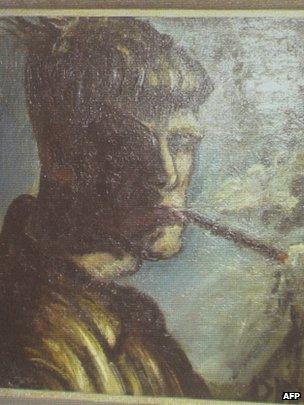Nazi art hoard: Allies 'returned some items' to owner
- Published
Artworks were looted from occupied countries or confiscated for being "degenerate"
Some of the works of Nazi-looted art presented in Munich on Tuesday were confiscated by the Allies after World War Two, and later returned to an art dealer, say German media reports.
Suddeutsche Zeitung says Hildebrand Gurlitt successfully lobbied the Allies for the return of more than 100 works.
Some of the items were among more than 1,400 art works found in the apartment of Gurlitt's son, Cornelius, it says.
The hoard's total value is estimated at about 1bn euros (£846m; $1.35bn).
Meanwhile, the German government says it now favours publishing some details about the art works; Jewish groups and others had said there should be immediate full disclosure of what is in the collection.
The Suddeutsche Zeitung newspaper says it based its findings on the transcripts of interviews conducted by the Allies with the art dealer, Hildebrand Gurlitt.
The newspaper says a list attached to one of the transcripts provides information about more than 100 pieces in what Hildebrand Gurlitt claimed to be his private collection.
Inquiries invited
According to the Suddeutsche Zeitung report, Hildebrand Gurlitt lobbied the Allies for the return of this collection, which had been confiscated in 1945, and at the time was stored at a United States depot in Wiesbaden, in south-west Germany.

This self-portrait by Otto Dix is believed to be one of those returned by the Allies to Hildebrand Gurlitt
The Allies returned this private collection - excluding two pieces - in 1950, says the report.
The list of items given back to Hildebrand Gurlitt is reported to include some of the works of art presented by German officials on Tuesday, including a painting by Marc Chagall and a self-portrait by Otto Dix.
Prosecutors say 121 framed and 1,285 unframed works were seized in Munich in March 2012 in the flat of Cornelius Gurlitt, who was being investigated for tax evasion.
They included previously unregistered works by Max Liebermann and Henri Matisse; there were also works by Pablo Picasso, Henri de Toulouse-Lautrec and Canaletto.
The issue of ownership is still being clarified.
Investigators have so far released very few details about the 1,400 works, saying that they are still continuing their investigations, and that people should come forward with inquiries.
But Jewish groups are among those that have called for the works to be made public immediately, so that the families of Holocaust victims can identify and recover art that was taken from them.
A German government spokesman, Steffen Seibert, told reporters on Wednesday that "the government is in favour of publishing information about those artworks where there are already indications that they may have been confiscated from people persecuted by the Nazis".
- Published5 November 2013
- Published5 November 2013
- Published4 November 2013
- Published4 November 2013
- Published4 November 2013